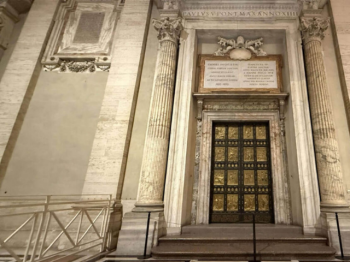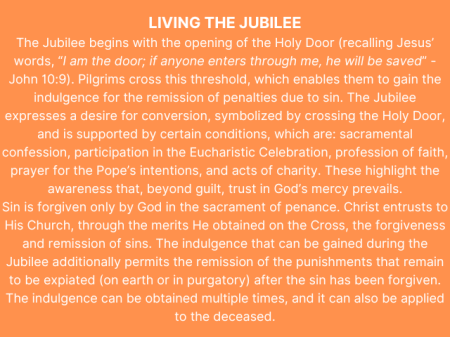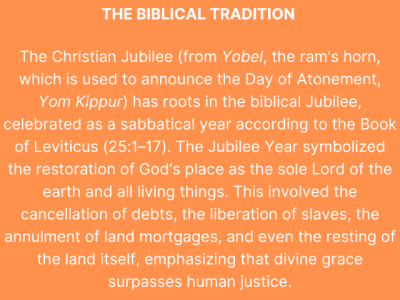The origins of the Jubilee
 The bull Antiquorum habet fida relatio, with which the first Roman Jubilee was proclaimed in 1300, was reproduced on the façade of the ancient Basilica of St. Peter, and this engraved document can now be found at the upper left of the Holy Door.
The bull Antiquorum habet fida relatio, with which the first Roman Jubilee was proclaimed in 1300, was reproduced on the façade of the ancient Basilica of St. Peter, and this engraved document can now be found at the upper left of the Holy Door.
A spontaneous and grassroots movement gave rise to the first Jubilee. Pope Boniface VIII, who lived in challenging times for the Church, responded to the unprompted requests of the faithful who, at the dawn of the new century, sought the remission of sins and punishments. In 1300, he proclaimed a Jubilee Year for the Church. Previously, there had been grants of remission for those who went to fight the Moors in Spain, for example, Alexander II, in 1063 or for the liberation of Jerusalem (Urban II, 1095). During a night in July 1216, Francis of Assisi obtained an extraordinary promise from Christ and the Virgin, who appeared to him that all who, through the centuries, prayed at the Porziuncola would receive full remission of sins (the Pardon of Assisi). Honorius III granted the desired indulgence and later extended it to pilgrims visiting the tomb of Thomas Becket (1220), who was murdered in Canterbury Cathedral. Finally, Pope Celestine V established the so-called Celestinian Pardon for pilgrims to the Basilica of Collemaggio (L’Aquila, September 29, 1294).
With the Bull Antiquorum habet fida relatio (“There is credible testimony from the ancients that great remissions and indulgences of sins are granted to those who visit the venerable Basilica of the Prince of the Apostles in Rome”), the first Roman Jubilee was proclaimed. Pilgrims flocked to Rome throughout the year 1300, as recounted by Cardinal Jacopo Stefaneschi in his De centesimo sive Iubileo anno liber. The Bull, widely reproduced and disseminated, was engraved on the façade of the old Basilica of Saint Peter and can now be found above and to the left of the Holy Door.





